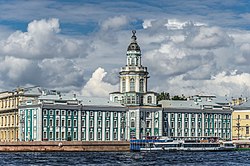Kunstkammer (Saint Petersburg)


The Kunstkammer ( Russian Кунсткамера 'art camera') is a museum in Saint Petersburg . Its holdings are among the most complete anthropological and ethnological collections in the world.
history
The Kunstkammer was the first museum in Russia to emerge from the private collections of Tsar Peter I. It was created as a cabinet of curiosities and made public for the first time when it was moved from the summer palace of Peter the Great to the Kikin Palace in 1719 . Even then, it consisted not only of the anatomical abnormalities that still shudder viewers today. As early as 1704, Peter had obliged the midwives to have miscarriages brought to the capital as medical demonstration material, where they were kept as preparations in the pharmacy's office. But the collection was soon expanded to include collections of stuffed animals, minerals, gems, scientific instruments and curiosities. 1716–1717 the collections of the pharmacologist Albertus Seba and those of the anatomist Frederik Ruyschs were acquired from Amsterdam . Everything was set up in a systematic order and expanded in a targeted manner. Peter the Great wanted to bring the spirit of European science closer to his population (or at least to the noble and bourgeois part of them). That is why the entrance was not only free, but as an incentive "every guest received a little refreshment, the gentlemen a glass of vodka, the ladies a cup of tea with carrot".
The striking new building of the Kunstkammer on the banks of the Neva opposite the Winter Palace , built in 1718 by the German architect Georg Johann Mattarnovi in the style of the “Petersburg Baroque” , was initially occupied by the St. Petersburg Academy of Sciences, founded in 1724 , to which the collections of the Kunstkammer were attached. In the 18th century, the presidium met regularly in the tower room. After the building was finally completed in 1727, the museum was also opened to the public. Even if, according to Peter's main interest, the collection contained more naturalia (natural history) than artificialia (man-made) objects, the giant Gottorf globe exhibited in the tower still represents the highlight of the Kunstkammer. The collection comprised a large one Amount of human and animal fetuses with anatomical deviations. The exhibits also include the heads of the lover of Catherine the First , Willem Mons and his sister Anna Mons, preserved in alcohol . At times, up to ten malformed people lived in the rooms of the Kunstkammer.
The museum contains a memorial to Mikhail Lomonosov , the eminent Russian polymath who worked here from 1741 to 1765. In the 19th century, the ethnographic collection areas in particular grew .
Since 1992 the Kunstkammer has been an independent museum and research institute within the History Department of the Russian Academy of Sciences . The full name is now: "Museum of Anthropology and Ethnography (Kunstkammer) named Peter the Great of the Russian Academy of Sciences" ( Музей антропологии и этнографии (Кунсткамера) им. Петра Велико ).
Directors of the Museum of Anthropology and Ethnography
- Leopold von Schrenck (1879–1894)
- Wilhelm Radloff (1894–1918)
- Wilhelm Barthold (1918–1921)
- Evfimij Karsky (1921–1930)
- Nikolai Matorin (1930-1933)
- Ivan Meshchaninov (1934–1937)
- Nikolai Kislyakov (1945–1948)
- Rudolf Its (1982–1990)
- Nikolai Girenko (1991-1992)
- Alexander Mylnikow (1992–1997)
- Tschuner Taksami (1997-2001)
- Yuri Tschistow (since 2001)
literature
- Wladimir Velminski: The Theatrum Naturae et Artis. In: Karl Schlögel u. a. (Ed.): Saint Petersburg, scenes of a city history. New York / Frankfurt 2007, pp. 63–74.
- Tatjana Stanjukowič: Art camera peterburgskoj Akademii nauk. Moscow 1953. (Russian)
Individual evidence
- ↑ Wladimir Velminski: Das Theatrum Naturae et Artis. In: Karl Schlögel et al. (Ed.): Sankt Petersburg, Schauplätze einer Stadtgeschichte. New York / Frankfurt 2007, p. 71.
- ↑ Stanjucovič, p. 48, quoted from Velminski, p. 68
- ↑ see the engl. Wikipedia: en: Georg Johann Mattarnovi
- ↑ 1734 is also mentioned as the year of completion. After a fire in 1747, further restoration work was necessary; the tower's free floors are a reconstruction based on old plans from 1949.
- ↑ Velminski, p. 71
Web links
- Art camera (english)
- Kunstkammer, Museum of Anthropology and Ethnography named Peter the Great (Saint Petersburg)
- Sankt Petersburg Kunstkammer celebrates its 300th birthday at Russia Beyond the Headlines : News from Russia
Coordinates: 59 ° 56 ′ 29.5 ″ N , 30 ° 18 ′ 16.1 ″ E